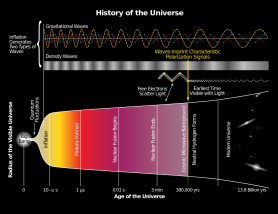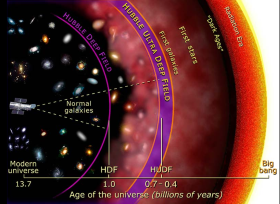The Big Board–Little Universe Project, part of Center for Perfection Studies• USA
Last update: 8 August 2017
Introduction
In December 2011 two teachers and about 80 high school students rather naïvely began to explore a geometric progression that first went down in size to the Planck Length then reversed to go back up all the way to the Observable Universe (most links open a tab or window and go to an in-depth Wikipedia page).
The first chart to be developed, pictured on the left, measures 60×11 inches. It is a view of the entire universe and has just over 200 base-2 exponential notations (dividing or multiplying by 2, over and over again). Thinking that this simple math was already part of academic work, they began asking friends and family, “What is right or wrong within our logic for this model?” A two-year search did not uncover any references to base-2 and the Planck Length.* In that time, asking around locally and then globally, many people were puzzled and asked, “Why haven’t we seen a base-2 scale of the universe before now?”
An Integrated Universe View
Dubbed Big Board – little universe, this project started as a curiosity; today, it is an on-going study to analyze and develop the logic and potential links from their simple mathematics to all the current mathematics that define the universe, all its parts, everything from everywhere, and from the beginning of time to this very moment in time. Their hope is that this simple logic has simple links to real realities. Their standing invitation is, Open To Everyone, to help. This chart follows the progressions from the smallest to the largest possible measurement of a length. Subsequent charts engage the other Planck base units. With more questions than answers, this group is trying to grasp the logic flows in light of current academic-scientific research. Progress is slow.
Yes, on December 19, 2011 the geometry classes in a New Orleans high school were introduced to the chart on the left (Planck Length to the Observable Universe). In December 2014 they began to track Planck Time to the Age of the Universe. When they added the other the Planck base units to each maximum value, it seemed to call out for a horizontally-scrolled chart to follow each line of data more easily. Natural inflation becomes self-evident. And, that opened the way to question the big bang theory, especially the first four epochs — the Planck Epoch, the Grand Unification Epoch, the Inflationary Epoch, and Electroweak Epoch. In their search for answers about this model, questions abound.
This first chart is very early work.
Click on it, then click on it again to enlarge it.
What’s next?
They ask, “Where are the informed critics to tell us where we are going wrong?” One rather brilliant, young physicist told them that the concept for this project is idiosyncratic. They quickly learned how right he was. Nobel laureates and scholars of the highest caliber were asked, “What is wrong with our picture? Where is our fallacy of misplaced concreteness?” The group is slowly analyzing the logic and developing their thoughts as web postings with the hope that somebody will say, “That’s wrong” and be able to tell them in what ways they have failed logically and mathematically.
 If not wrong, the extension of their basic logic could begin to yield rather far-reaching results. For example, the Big Bang theory could get a special addendum, the first 67 notations. That would make it simple, symmetric (entirely relational), predictive, and totally other. The entire universe could get an infrastructure of geometries whereby many issues in physics, chemistry and biology could be redressed. The finite-infinite relation is opened for new inquiries. In this model of the universe, time-and-space are derivative of two quantitative qualities of infinity: continuity-and-symmetry. As a result, these derivative relations begin to have an inherent qualitative or value structure. If so, ethics and the studies of the Mind (the discernment of qualities) just might, for the first time in history, become part of a scientific-mathematical continuum. A trifurcated definition of the individual may emerge whereby people are simultaneously within the small scale, human scale, and large scale universe. Embracing a different sense of the nature of space and time by which both are localized by notation is surely enough; yet there will always be more. There are many working postings that have been written since their first chart; all of it needs constant updating. Many can be found through the top navigation bar option, INDEX.
If not wrong, the extension of their basic logic could begin to yield rather far-reaching results. For example, the Big Bang theory could get a special addendum, the first 67 notations. That would make it simple, symmetric (entirely relational), predictive, and totally other. The entire universe could get an infrastructure of geometries whereby many issues in physics, chemistry and biology could be redressed. The finite-infinite relation is opened for new inquiries. In this model of the universe, time-and-space are derivative of two quantitative qualities of infinity: continuity-and-symmetry. As a result, these derivative relations begin to have an inherent qualitative or value structure. If so, ethics and the studies of the Mind (the discernment of qualities) just might, for the first time in history, become part of a scientific-mathematical continuum. A trifurcated definition of the individual may emerge whereby people are simultaneously within the small scale, human scale, and large scale universe. Embracing a different sense of the nature of space and time by which both are localized by notation is surely enough; yet there will always be more. There are many working postings that have been written since their first chart; all of it needs constant updating. Many can be found through the top navigation bar option, INDEX.
Notes, lesson plans and posts (and all new posts) are being consolidated and linked from this homepage. Now called, The Big Board – little universe Project, it is a Science-Technology-Engineering-Mathematics (STEM) application. Secondary schools from around the world are being invited to join the exploration. Daily work on the topic is being researched, developed, and communicated through a sister website, http://81018.com.
The earliest postings and blogs were done by Bruce Camber within a section of his website — SmallBusinessSchool.org. That site supports a television series, Small Business School, that he and his wife, Hattie Bryant, started. It aired for 50 seasons on most PBS-TV stations throughout the USA and on thousands around the world via the Voice of America-TV affiliates.
Articles and blogs have been posted on WordPress, LinkedIn, Blogger, and Facebook (often those links open in new windows). An April 2012 article, formatted for and displayed within Wikipedia for a few weeks, was deleted on May 2, 2012 as “original research” by highly-specialized Wikipedia editors. Only then did this little group of teachers and students finally begin to believe that base-2 notation had not already been applied to the Planck base units. And, as they have grown in their analyses, it has become increasingly clear that this area of simple math and simple logic is a relatively new exploration and that notations 1-to-67 may be a key to unlock a new understanding of the nature of physical reality.
The challenge is to study the logic flow within their many charts, all based on the Planck base units, both up and down and across, to build on the question, “Is this logic simple and consistent? What does it imply about the nature of the universe?”
So, even now, there is much more to come. At the end of the year, 2015, a Lettermanesque Top Ten was added. In January 2016 an article, Constructing the Universe from Scratch, emerged. In April 2016 the horizontally-scrolled chart provided a better sense of the flow and of phase transitions. Still a “rough draft” this project has a long way to go! Bruce Camber says, “You are most welcome to add your comments, questions, ideas and insights!”
* Footnote: In 1957 Kees Boeke did a very limited base-10 progression of just 40 steps. It became quite popular. In July 2014, physicists, Gerard ‘t Hooft and Stefan Vandoren wrote a scholarly update using base-10. Notwithstanding, base-2 is 3.3333+ times more granular than base-10 plus it mimics cellular reproduction and other naturally bifurcating processes in mathematics, physics, chemistry, biology, topology, botany, architecture, cellular automaton and information theory; it has a geometry; it has the Planck base units, and, it has a simple logic and so much more.
If you would like to contribute content to this site, please contact Bruce Camber
at camber – (at) – bblu.org or click here for more contact information. Thank you.










 “Here are the first openings, the initial pathways, between
“Here are the first openings, the initial pathways, between 